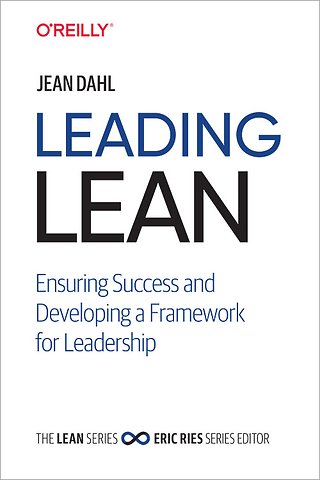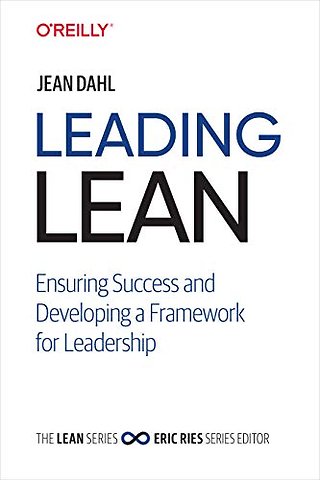


Jean Dahl has been a serial entrepreneur, consultant, thought leader, and yes, even a corporate executive during her career.
Meer over Jean DahlLeading Lean
Ensuring Success and Developing a Framework for Leadership
Gebonden Engels 2020 1e druk 9781492046295Samenvatting
Companies from startups to corporate giants face massive amounts of disruption today. Now more than ever, organizations need nimble and responsive leaders who know how to exploit the opportunities that change brings. In this insightful book, Jean Dahl, a senior executive and expert in the Lean mindset and its methods, demonstrates why you need to embrace Modern Lean principles and thinking to redefine leadership in this age of digital disruption in order to continuously evolve the Lean enterprise.
Drawing on nearly three decades of corporate and consulting experience, Ms. Dahl lays out a new holistic framework for developing Modern Lean leaders. Through personal experiences and compelling real-world case studies, she explains specific steps necessary for you and your company to proactively understand and respond to change.
- Understand the leadership challenges Lean leaders face in our 21st century global economy
- Explore the six dimensions of the Modern Lean Framework™
- Learn and apply the nine steps necessary to become a Lean leader
- Use Modern Lean methods to build a culture of continuous learning that can be sustained and maintained within your organization
- Seize competitive advantage by embracing Modern Lean to tbuild an enterprise that understands how to respond to disruption
Specificaties
Lezersrecensies
Inhoudsopgave
Preface
O’Reilly Online Learning
How to Contact Us
Acknowledgments
1. Overcoming Today’s Crisis in Leadership
Delivering Customer Value: An Enterprise’s Ultimate Goal
Defining Value
Recognizing the Crisis in Leadership Today
Ten 21st-Century Leadership Challenges
Challenge #1: Self-Development for Leaders
Challenge #2: Outdated Leadership and Management Styles
Challenge #3: Customer Centricity and Value Delivery
Challenge #4: Prioritizing Profit Above All Else
Challenge #5: Cost Reduction Survival Strategies
Challenge #6: Strategic Misalignment
Challenge #7: Hierarchies and Silos
Challenge #8: Traditional Development Practices
Challenge #9: Technological Advances and Global Competition
Challenge #10: Outmoded Workforce Development Practices
Why Agility Isn’t Easy for Leaders
Leading Lean Is All About Embracing Agility
Conclusion
2. The Modern Lean Framework™
Staving Off Extinction through Continuous Evolution
Leading in Our 21st-Century Connected World
Understanding the Journey Ahead of You
Toyota and the Lean Mindset
The Toyota Production System
The Pillars of The Toyota Way
Leading in the Era of Modern Lean
Leading Self
Leading Others
Leading Outside In
Leading Enterprise Wide
Leading Innovation
Leading Culture
Conclusion
3. Leading Self
Believing and Trusting in Yourself Through Self-Development
Developing a Healthy Mind and Body
Eliminating Chaos
Keeping a Healthy Body
Make Time for Yourself
Understand Your Own Reality
Developing a Bias Toward Action
Facing Challenging Situations Head-On
Leveraging Common Sense for Problem Solving and Decision Making
Just the Facts
An Ounce of Common Sense
Tapping into Your Emotional Intelligence
Displaying Persistence and Tenacity
Allowing Yourself to Always Become the Student
Conclusion
4. Leading Others
Defining Servant Leadership for the 21st Century
Origins of Servant Leadership
Characteristics of Servant Leadership
Why Servant Leaders Are So Important to the Lean Enterprise
Becoming a Lean Servant Leader
Respecting Others on the Road to Continuous Improvement
Giving Context to Respecting Others
Thinking with a Kaizen Mind
Acknowledging Your Responsibility to Develop Others
Learning to Serve While Developing Others
Kaizen and the PDCA Cycle
The Evolution of PDCA and TBP
Learning to Serve through TBP
Case Study: The Eight Steps of TBP in Action
Step 1: Clarify the Problem (Plan)
Step 2: Break Down the Problem (Plan)
Step 3: Set Targets (Plan)
Step 4: Perform Root Cause Analysis (Plan)
Step 5: Develop Countermeasures (Plan)
Step 6: See Countermeasures Through (Do)
Step 7: Monitor Both Results and the Process (Check)
Step 8: Standardize Successful Processes (Act)
Using OJD to Develop Others
Step 1: Pick a Problem with Your Team (Plan)
Step 2: Appropriately Divide the Work Among Accountable Team Members, Making the Direction Compelling (Plan)
Step 3: Execute within Broad Boundaries, Monitor, and Coach (Do and Check)
Step 4: Feedback, Recognition, and Reflection (Act)
Conclusion
5. Leading Outside In
Measuring Success in Customer-Centric Companies
Churn Rate
Customer Lifetime Value
Net Promoter Score
Zeroing In on Your Target: Customer Experience
Understanding the Eight Stages of CXLC
Identifying Customer Personas
Developing Relevant Customer Personas
Keeping Personas Simple
Designing Customer Journeys That Matter
Research
Evaluate
Purchase
The Role of Emotions in the Customer Experience
Conducting Customer Experience Journey Mapping (CXJM)
Building a Mindful Omnichannel Customer Experience Strategy
How Do You Define Omnichannel, Anyway?
BMW, “The Ultimate Driving Machine”
BMW’s Crystal-Clear Messaging
The BMW OCXS
Considerations for Building a Mindful OCXS
Building a Comprehensive OCXS in Eight Steps
Conclusion
6. Leading Enterprise Wide
Recognizing the Importance of Enterprise Alignment
Understanding the Importance of Alignment and Engagement
Starting with the Endgame in Mind
Building a Centralized Strategic Decision-Making Framework
Understanding the Strategic Planning Process
Nine Steps to Creating Your Strategic Planning Canvas
The New Horizons Strategic Planning Canvas
Creating Your Investment Strategy
Developing a Successful Investment Strategy: Apple Disrupts Sony
Factors to Consider When Setting Your Targets
Developing Your Investment Allocation Targets
Developing Your Strategic Roadmap
Building the New Horizons Strategic Roadmap
Releasing Value in Increments: MVP Release Planning
Completing the MVP Release Plan
Building the New Horizons Service Department MVP Release Plan
Conclusion
7. Leading Innovation
Fighting Off Extinction Through Innovation
Innovation Isn’t New!
Defining the Qualities of Innovation
Thinking with a Disruptive Mind
Examining the Sources of Disruption
Finding Disruption in the Voice of Your Customer
Seven Steps to Conducting a VoC Analysis
Achieving Success Through Innovation
Unearthing Apple’s Epic Failure
Learning from LISA
Designing and Building Innovative and Disruptive Products and Services
Defining the Design Thinking + Lean Startup Cycle
Leveraging the Lean Product Canvas
The New Horizons Service and Repair Mobile Device App Canvas
Developing Iteratively and Incrementally
Fostering Innovation Through Continuous Learning
Conclusion
8. Leading Culture
Defining “Culture”
Motivation: The Essential Ingredient
Defining Culture in the Context of the Lean Enterprise
Defining the Leading Culture Dimension
Quadrant I: Identifying Your Beliefs
Quadrant II: The Role of Values in Defining Culture
Quadrant III: Using Strategy to Solidify Your Behaviors
Quadrant IV: Bringing a Culture to Life Through Your Actions
Executing on the Eight Steps to a Lean Culture: New Horizons
Step 1: Assess Your Current Culture
Step 2: Establish Your Lean Belief System
Step 3: Identify the Values That Define Your Culture
Step 4: Define Your Motivating Behaviors by Creating Your Strategic Framework
Step 5: Formalize the Actions Required to Transform Your Culture
Step 6: Connect Strategy to Execution by Implementing OKRs
Step 7: Conduct CFR Check-Ins to Ascertain Forward Progress
Step 8: Report Progress and Make Adjustments
Focusing on the Critical Need for Continuous Performance Management
Understanding the Benefits of CPM
Seven Things That Must Be True to Develop a Lean Culture
Conclusion
9. Becoming a Self-Led Lean Leader
Seven Things That Must be True to Develop Yourself into a Lean Leader
Understanding the Lean Leader’s Self-Development Process
Finding Your Sensei
Nine Steps to Becoming a Self-Led Lean Leader
Step 1: Assess Your Leading Self Beliefs
Step 2: Define Your Values and Purpose
Step 3: Define Your Lean Leadership Objectives
Step 4: Identify Your Growth Opportunities
Step 5: Develop Your Key Results (KRs)
Step 6: Define Your Tactics and Operational Tasks
Step 7: Engage and Execute
Step 8: Measure and Report Results
Step 9: Evolve and Optimize the Process
Summary: Jannie Peterson’s Q1 Lean Leader’s Self-Development Canvas
Conclusion: Committing Yourself to the Modern Lean Leader’s Way
Index
Vaak samen gekocht
Anderen die dit boek kochten, kochten ook
Rubrieken
- advisering
- algemeen management
- coaching en trainen
- communicatie en media
- economie
- financieel management
- inkoop en logistiek
- internet en social media
- it-management / ict
- juridisch
- leiderschap
- marketing
- mens en maatschappij
- non-profit
- ondernemen
- organisatiekunde
- personal finance
- personeelsmanagement
- persoonlijke effectiviteit
- projectmanagement
- psychologie
- reclame en verkoop
- strategisch management
- verandermanagement
- werk en loopbaan







